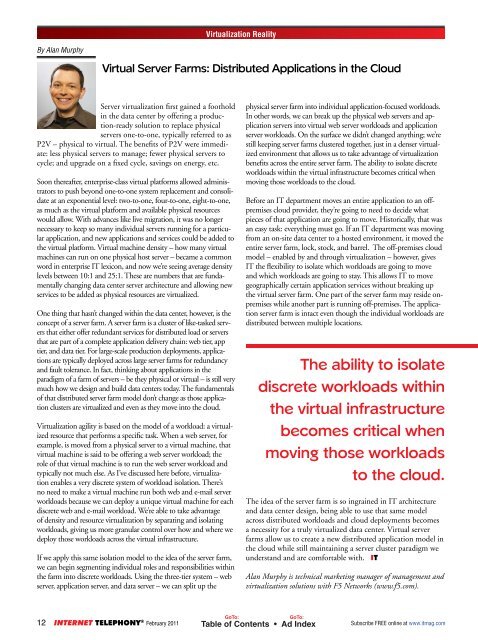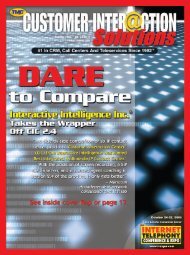service provider news - TMC's Digital Magazine Issues
service provider news - TMC's Digital Magazine Issues
service provider news - TMC's Digital Magazine Issues
- No tags were found...
Create successful ePaper yourself
Turn your PDF publications into a flip-book with our unique Google optimized e-Paper software.
Virtualization RealityBy Alan MurphyVirtual Server Farms: Distributed Applications in the CloudServer virtualization first gained a footholdin the data center by offering a production-readysolution to replace physicalservers one-to-one, typically referred to asP2V – physical to virtual. The benefits of P2V were immediate:less physical servers to manage; fewer physical servers tocycle; and upgrade on a fixed cycle, savings on energy, etc.Soon thereafter, enterprise-class virtual platforms allowed administratorsto push beyond one-to-one system replacement and consolidateat an exponential level: two-to-one, four-to-one, eight-to-one,as much as the virtual platform and available physical resourceswould allow. With advances like live migration, it was no longernecessary to keep so many individual servers running for a particularapplication, and new applications and <strong>service</strong>s could be added tothe virtual platform. Virtual machine density – how many virtualmachines can run on one physical host server – became a commonword in enterprise IT lexicon, and now we’re seeing average densitylevels between 10:1 and 25:1. These are numbers that are fundamentallychanging data center server architecture and allowing new<strong>service</strong>s to be added as physical resources are virtualized.One thing that hasn’t changed within the data center, however, is theconcept of a server farm. A server farm is a cluster of like-tasked serversthat either offer redundant <strong>service</strong>s for distributed load or serversthat are part of a complete application delivery chain: web tier, apptier, and data tier. For large-scale production deployments, applicationsare typically deployed across large server farms for redundancyand fault tolerance. In fact, thinking about applications in theparadigm of a farm of servers – be they physical or virtual – is still verymuch how we design and build data centers today. The fundamentalsof that distributed server farm model don’t change as those applicationclusters are virtualized and even as they move into the cloud.Virtualization agility is based on the model of a workload: a virtualizedresource that performs a specific task. When a web server, forexample, is moved from a physical server to a virtual machine, thatvirtual machine is said to be offering a web server workload; therole of that virtual machine is to run the web server workload andtypically not much else. As I’ve discussed here before, virtualizationenables a very discrete system of workload isolation. There’sno need to make a virtual machine run both web and e-mail serverworkloads because we can deploy a unique virtual machine for eachdiscrete web and e-mail workload. We’re able to take advantageof density and resource virtualization by separating and isolatingworkloads, giving us more granular control over how and where wedeploy those workloads across the virtual infrastructure.If we apply this same isolation model to the idea of the server farm,we can begin segmenting individual roles and responsibilities withinthe farm into discrete workloads. Using the three-tier system – webserver, application server, and data server – we can split up thephysical server farm into individual application-focused workloads.In other words, we can break up the physical web servers and applicationservers into virtual web server workloads and applicationserver workloads. On the surface we didn’t changed anything; we’restill keeping server farms clustered together, just in a denser virtualizedenvironment that allows us to take advantage of virtualizationbenefits across the entire server farm. The ability to isolate discreteworkloads within the virtual infrastructure becomes critical whenmoving those workloads to the cloud.Before an IT department moves an entire application to an offpremisescloud <strong>provider</strong>, they’re going to need to decide whatpieces of that application are going to move. Historically, that wasan easy task: everything must go. If an IT department was movingfrom an on-site data center to a hosted environment, it moved theentire server farm, lock, stock, and barrel. The off-premises cloudmodel – enabled by and through virtualization – however, givesIT the flexibility to isolate which workloads are going to moveand which workloads are going to stay. This allows IT to movegeographically certain application <strong>service</strong>s without breaking upthe virtual server farm. One part of the server farm may reside onpremiseswhile another part is running off-premises. The applicationserver farm is intact even though the individual workloads aredistributed between multiple locations.The ability to isolatediscrete workloads withinthe virtual infrastructurebecomes critical whenmoving those workloadsto the cloud.The idea of the server farm is so ingrained in IT architectureand data center design, being able to use that same modelacross distributed workloads and cloud deployments becomesa necessity for a truly virtualized data center. Virtual serverfarms allow us to create a new distributed application model inthe cloud while still maintaining a server cluster paradigm weunderstand and are comfortable with. ITAlan Murphy is technical marketing manager of management andvirtualization solutions with F5 Networks (www.f5.com).GoTo:GoTo:12 INTERNET TELEPHONY ® February 2011 Table of Contents • Ad IndexSubscribe FREE online at www.itmag.com









